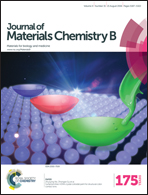Photocrosslinkable chitosan hydrogels functionalized with the RGD peptide and phosphoserine to enhance osteogenesis
Abstract
Hydrogels derived from naturally occurring polymers are attractive matrices for tissue engineering. Here, we report a biofunctional hydrogel for specific use in bone regeneration by introducing Arg–Gly–Asp (RGD)-containing cell adhesive motifs and phosphorylated serine residues, which are prevalent in the native bone extracellular matrix and known to promote osteogenesis by enhancing cell–matrix interactions and hydroxyapatite nucleation, into photopolymerizable methacrylated glycol chitosan (MeGC). Incorporation of phosphoserine into MeGC hydrogels increased the ability of the hydrogels to nucleate minerals on their surfaces. RGD incorporation enhanced cell–matrix interactions by supporting attachment, spreading, and proliferation of bone marrow stromal cells (BMSCs) encapsulated in the hydrogels. Moreover, co-modification of MeGC hydrogels with RGD and phosphoserine synergistically increased the osteogenic differentiation of encapsulated BMSCs in vitro. The bone healing capacity of the modified hydrogels was further confirmed in a mouse calvarial defect model. These findings suggest a promising hydrogel platform with a specific microenvironment tailored to promote osteogenesis for clinical bone repair.


 Please wait while we load your content...
Please wait while we load your content...